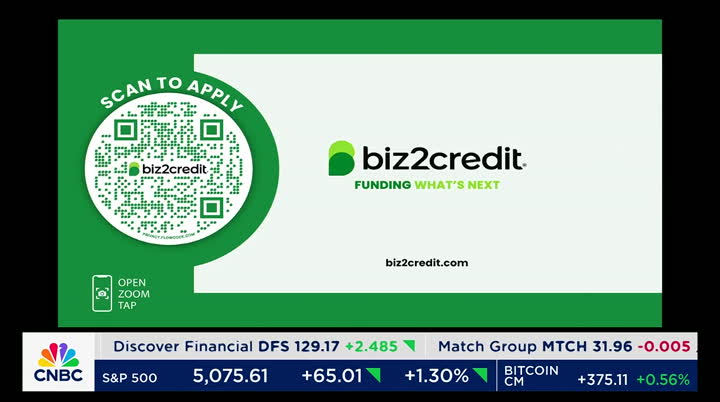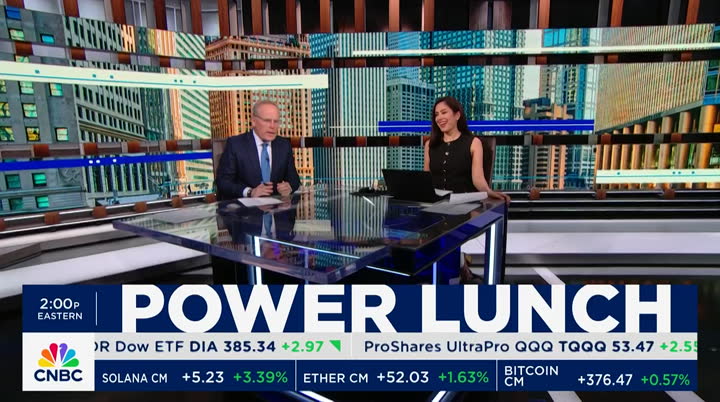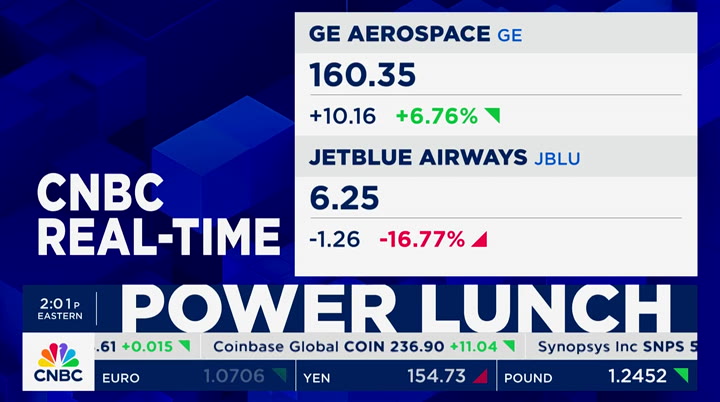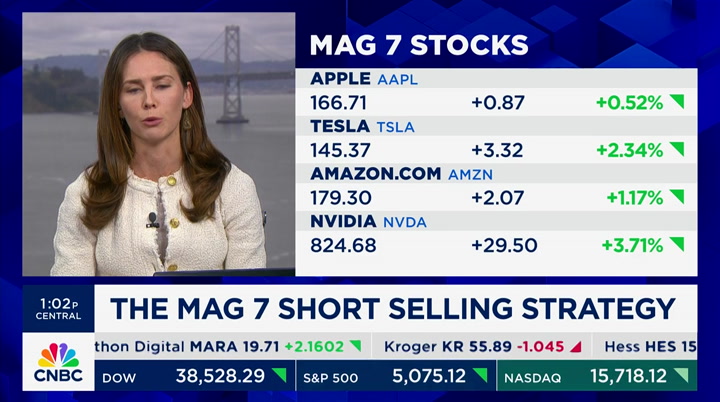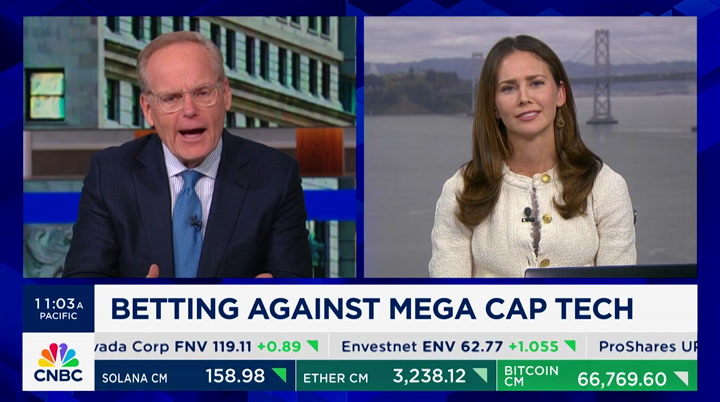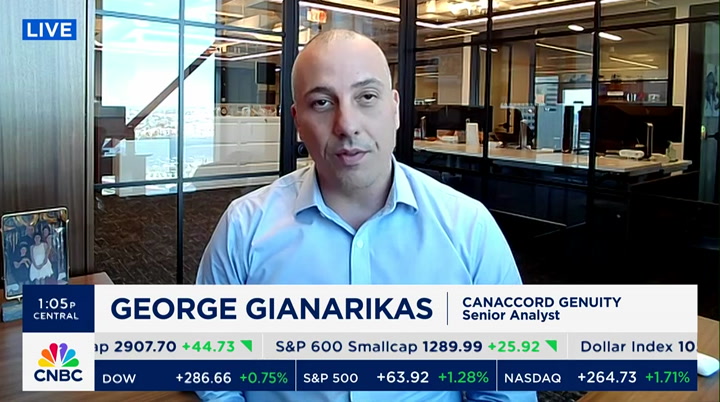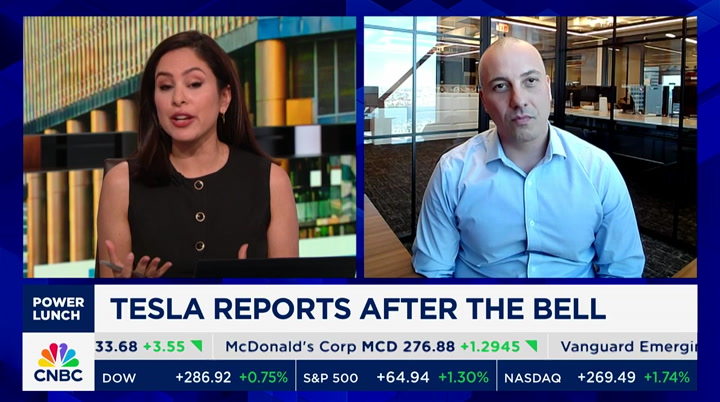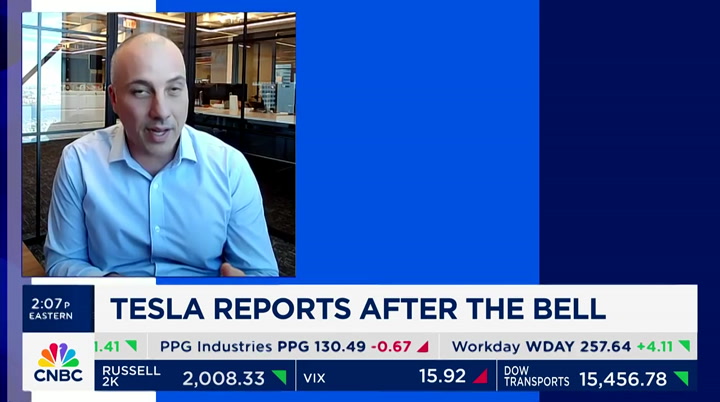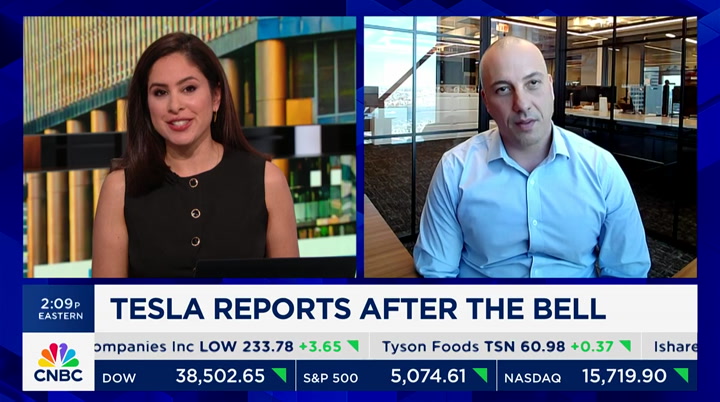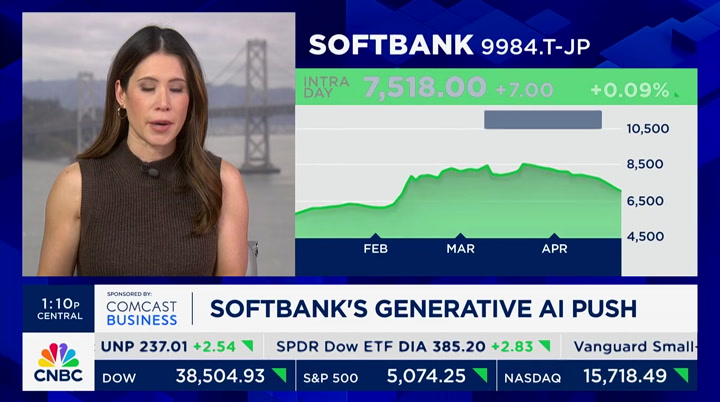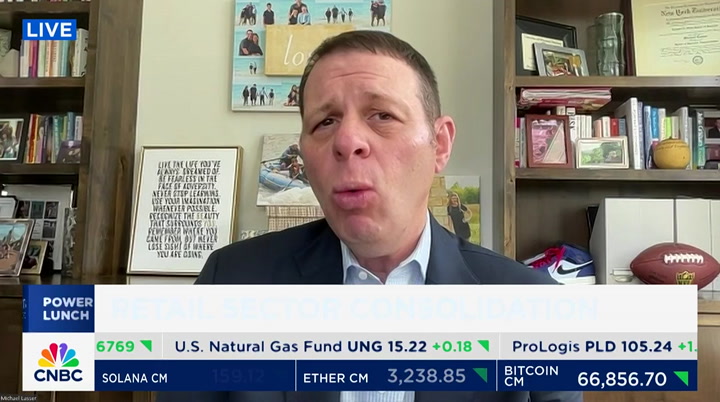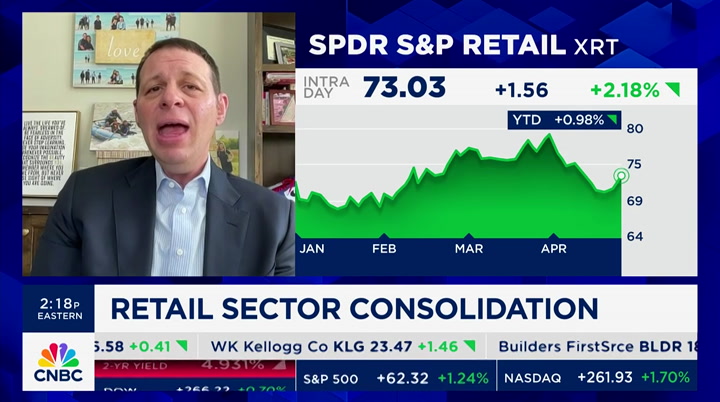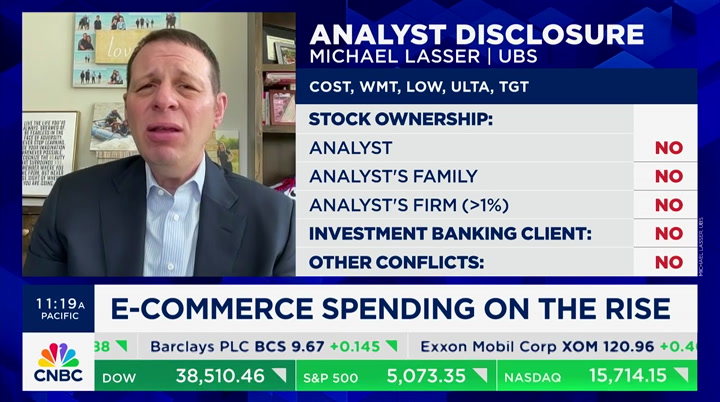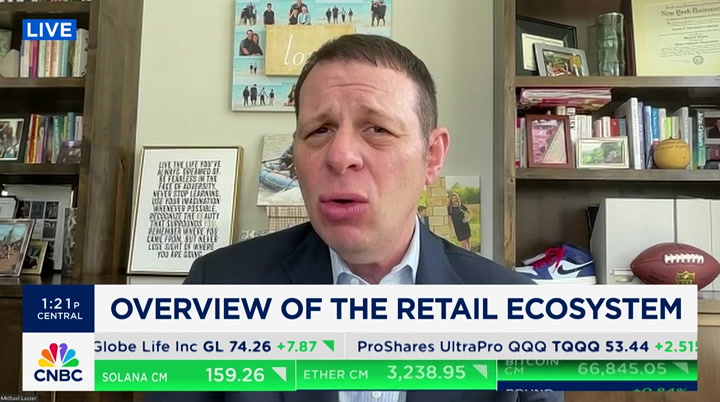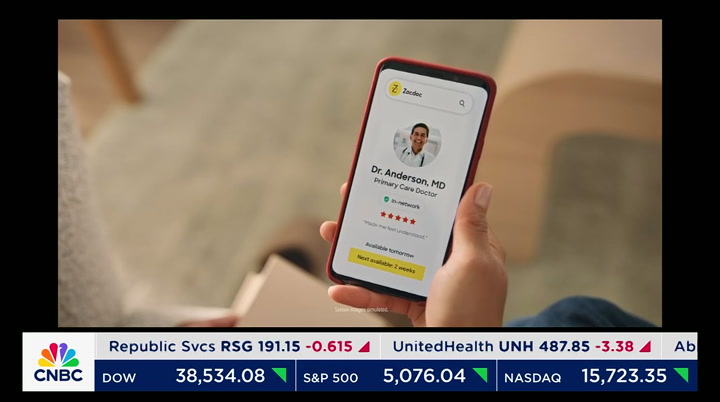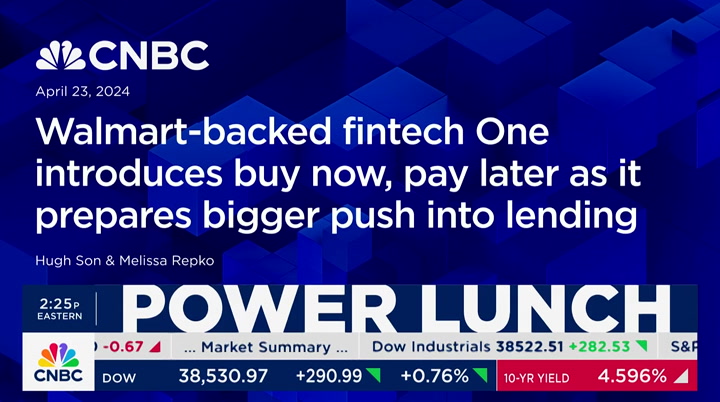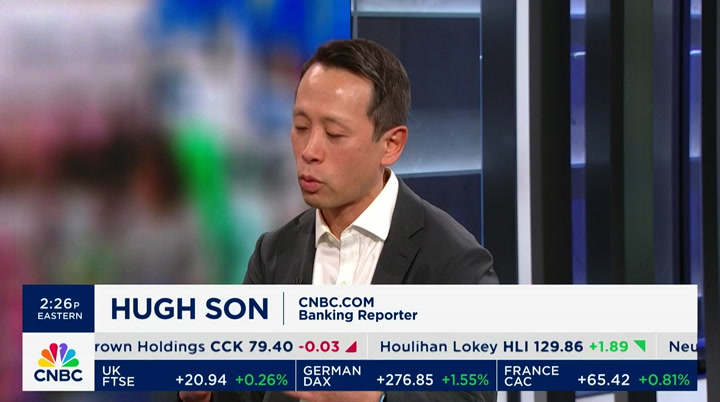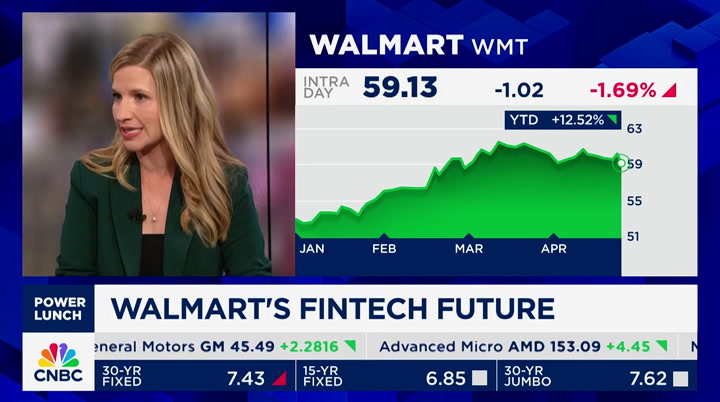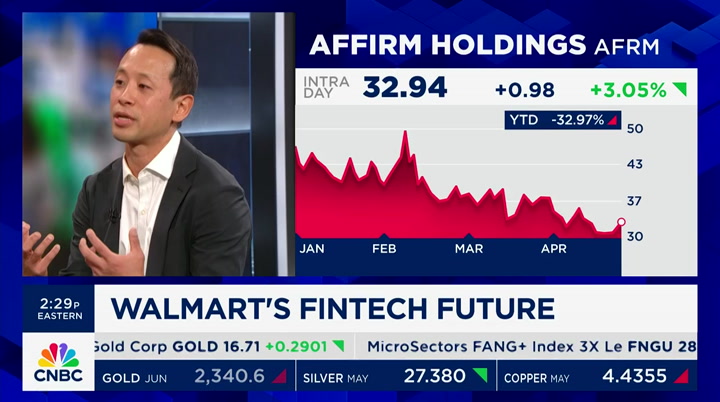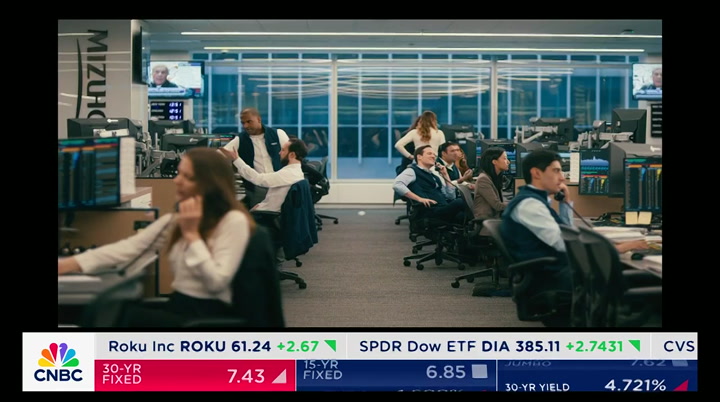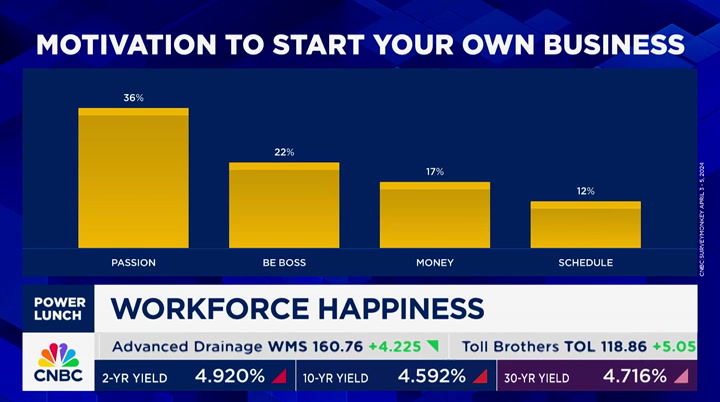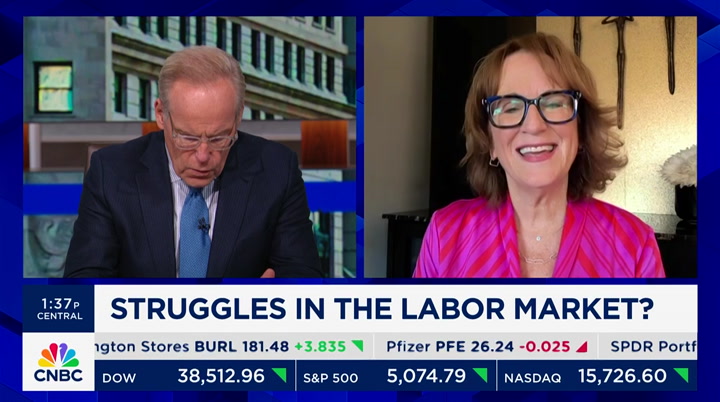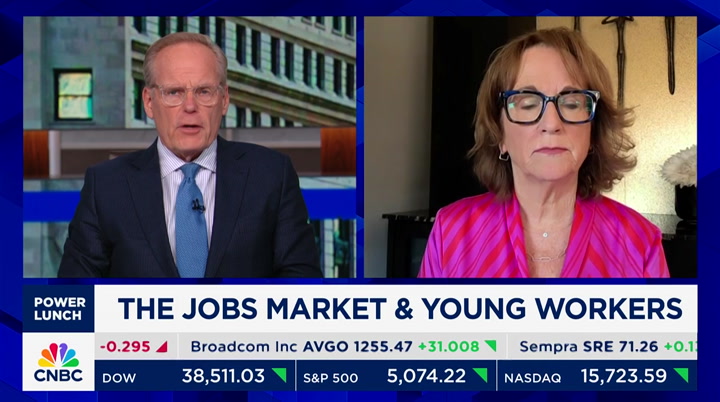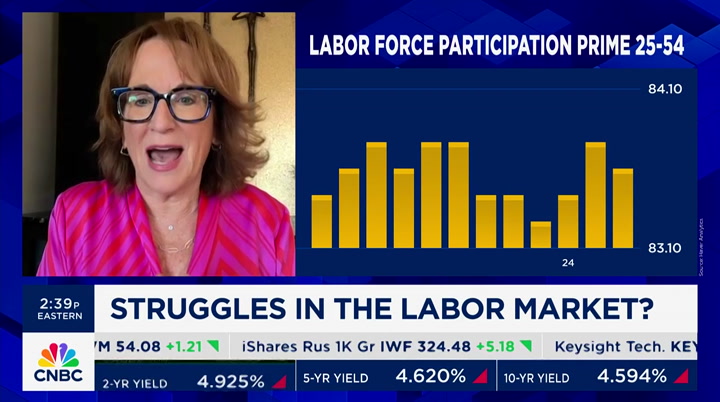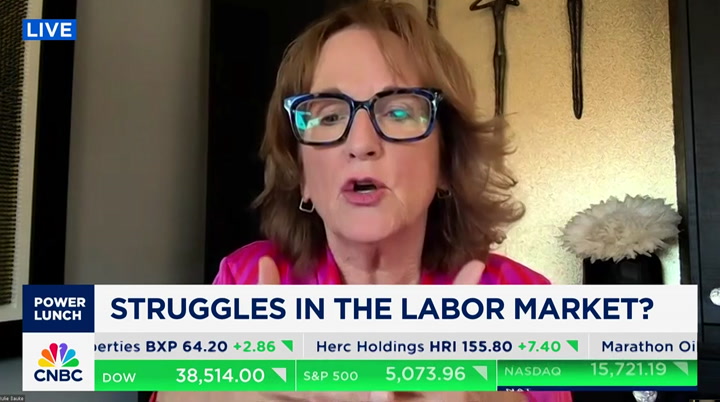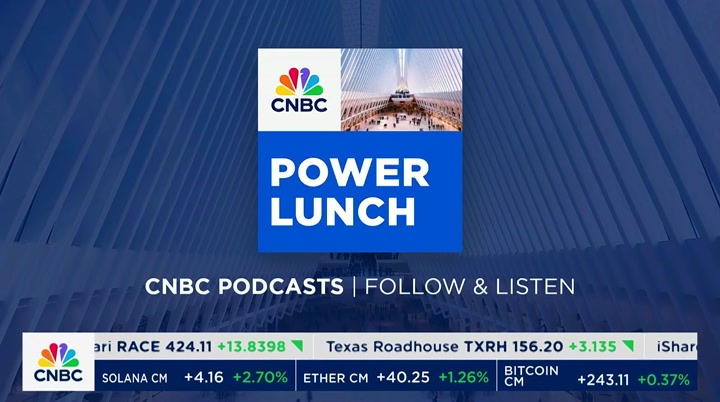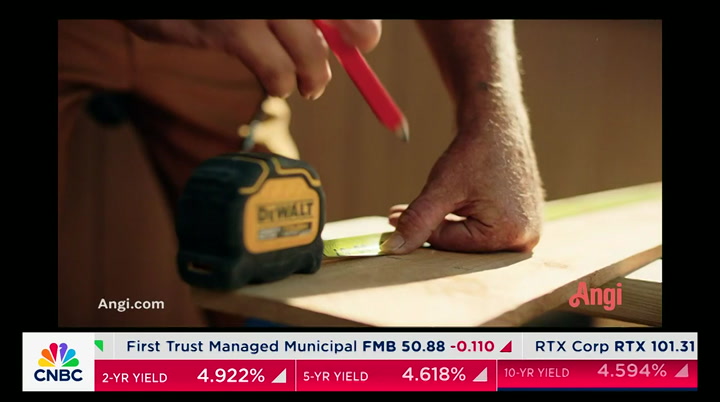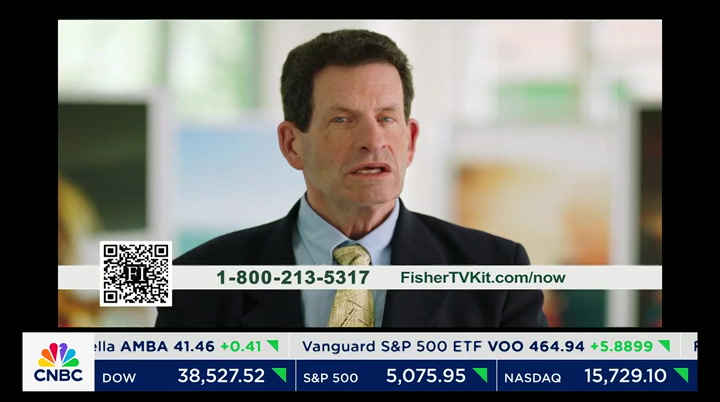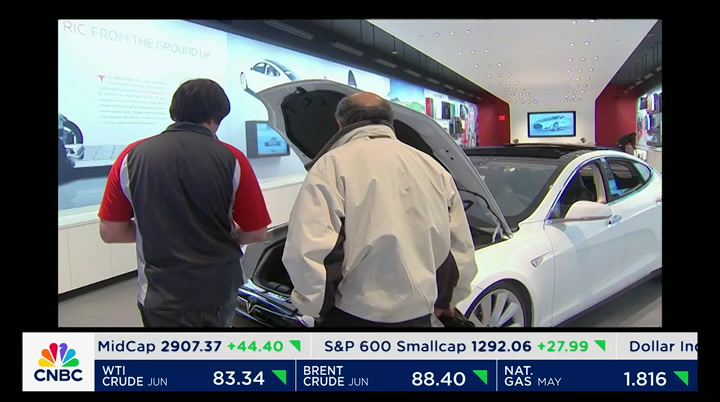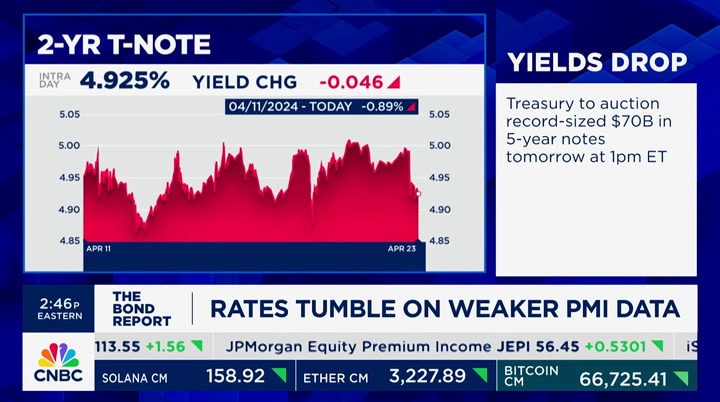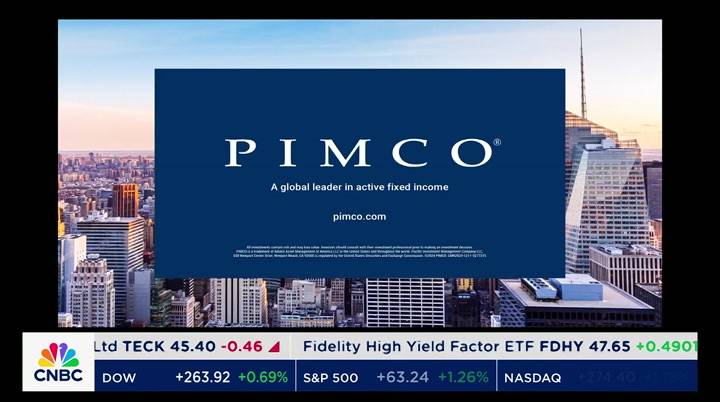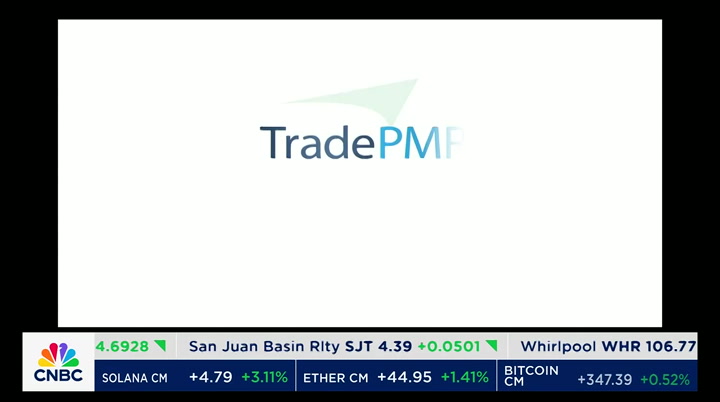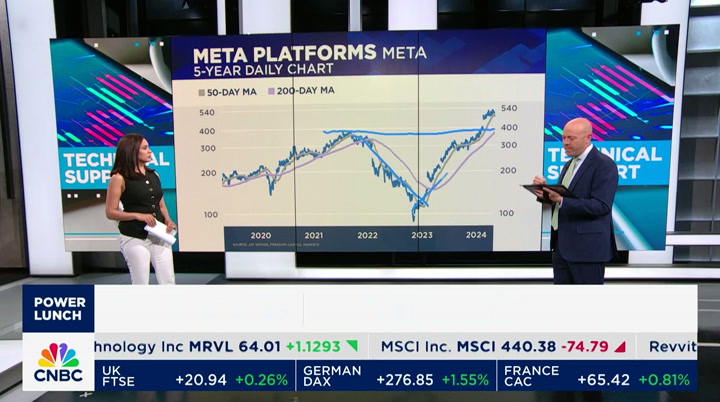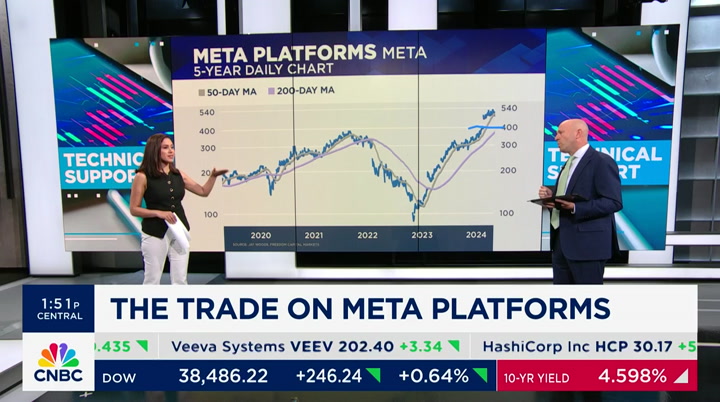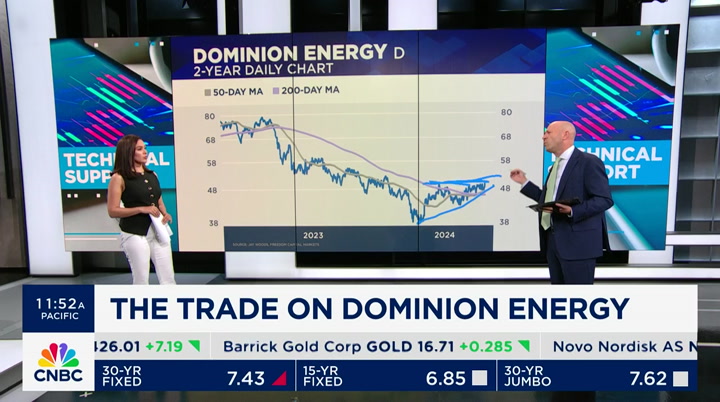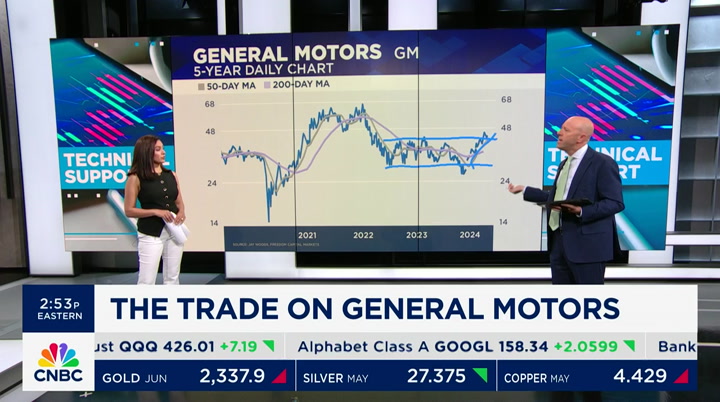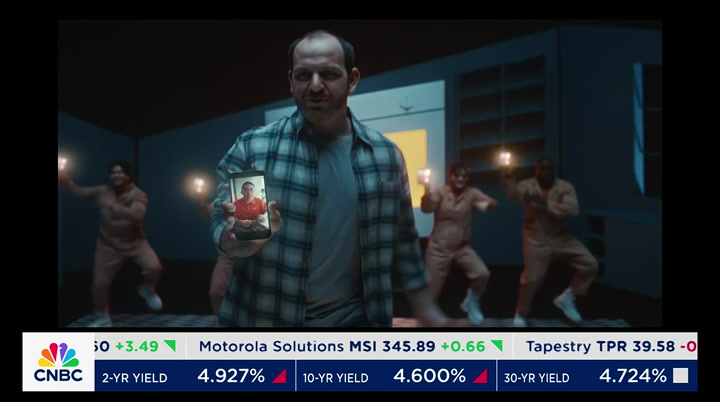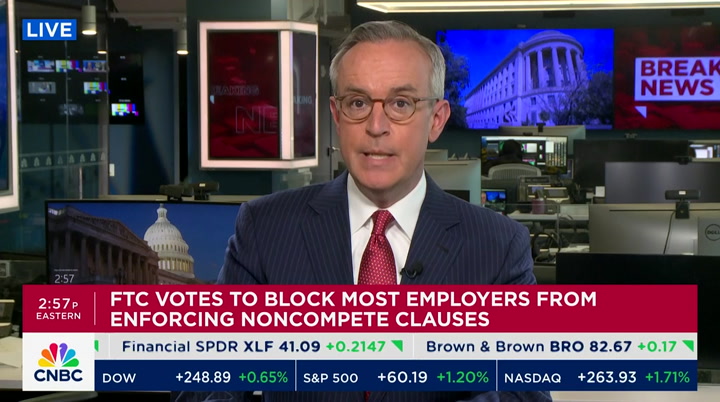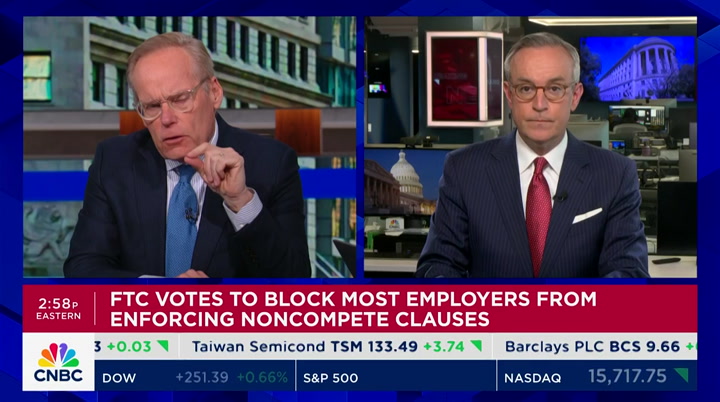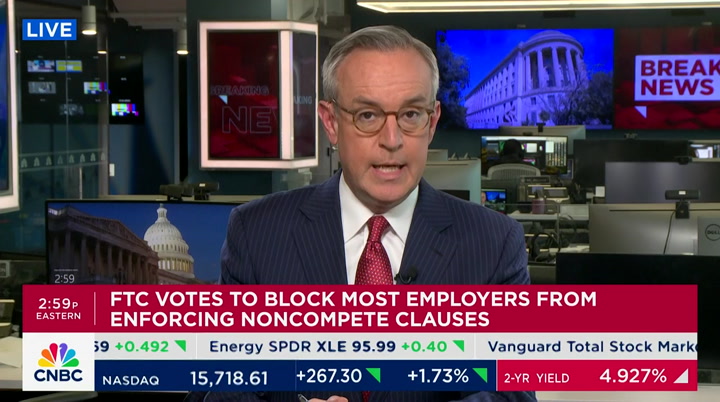tv Power Lunch CNBC April 23, 2024 2:00pm-3:00pm EDT
2:00 pm
♪(voya)♪ there are some things that work better together. like your workplace benefits and retirement savings. voya provides tools that help you make the right investment and benefit choices. so you can reach today's financial goals and look forward to a more confident future. voya, well planned, well invested, well protected. ♪ hi, everybody. welcome to "power lunch. alongside seema mody, i'm tyler mathisen welcome. glad you could be with us on a tuesday. ahead on the program, the huge week for earnings continues today with tech, energy, autos, airlines, consumer staples we'll break down all the key reports. plus, further, a new report from ubs warning 45,000 retailers are at risk over the next few years we ask the analysts which names are on the chopping block and which will remain strong but first, let's take a look at where markets are trading right now. we're actually at the highs of
2:01 pm
the day with the s&p 500 up 1.3%, building on the gains from yesterday. biotech and technology stocks bouncing back with ten of the 11 s&p sectors trading in positive territory. and let's draw your attention to spotify, up a whopping 16%, highest level since march of 2021 on the back of its earnings beat also, check out jetblue, sinking after reporting worse than expected revenue. on the other hand, aviation engineer making air owe maker ge autos, gm up beating on earnings we'll take a technical look at that name further ahead. another name, that would be tesla reporting after the bell that name along with other big tech stocks become the target of short sellers. for that we turn to kate rooney. hi, kate. >> hi, tyler the bears are betting against big techs short sellers and the magnificent seven, weekly profit
2:02 pm
of $10 billion that was an all-time high during that nasdaq sell-off the tech giants mostly report this week and they are the most shorted stocks in the u.s. markets. that's according to s3 partners. nvidia number one, followed by microsoft, apple, tesla and meta, amazon and alphabet. there's also been negative sentiment around these companies. but the short interest, it might be more about downside protection and hedging. investors are using megacap tech to hedge their overall portfolios it's for fishlt than going long material they are cheap to borrow and short because they're so liquid. he described them as a hedge with, quote, serious afterburners since they get the biggest kick in the teeth if the market goes the wrong way for them, aside from last week shorting big tech, it's been a lot less profitable. nvidia shorts, for example, down 35% this year. meta shorts down 27%, amazon,
2:03 pm
microsoft, alphabet bears are all in the red of the mag seven, it's only been profitable to short apple and short tesla. shorting tesla, though, that's been risky bears have lost a total $52.5 billion, shorting tesla since inipo, only two years have been profitable for short sellers this is on track to be one of them the shorts are up $9 billion this year, guys. >> how do we know how much shorts, as an agoraget, have made or lost, across these names that you mentioned i'm just wondering, how do you determine that >> so, thanks to s3 partners, great about sending us some of this data, this is mostly hedge funds, by the way. i should mention this is not a lot of retail interest they measure this based on how much is being borrowed, which they can see sort of the percentage of the float that's shorted. so, they calculate that. it sounds like they have sort of a proprietary model. i've asked that myself, tyler.
2:04 pm
they're good with coming out with some of the tyler there's a variety of different data points. the percentage of the float, so echbl though these tech names are the most widely shorted, you see certain stocks with a i hooer percentage of the float, meaning there's more short interest in those particular names. they tend to be more volatile. but because big tech is so ubiquitous, they are used as that firm said, as s3 said, as sort of a hedge for broader portfolios if your going -- instead of shorting the qs, just short one of these big tech names. it's also a way to keep your portfolio a little tighter instead of going out and buying 50 stocks and shorting you can just short those big ones and you're sort of evened out there. so it does reflect sort of this bigger portfolio strategy that we're seeing. >> interesting data, kate. thank you for bringing that to us that's kate rooney. let's dive in deeper with tesla. that's down 10%. here to discuss is managing
2:05 pm
director and senior analyst, currently having a buy rating on tesla, with a $304 price target. george, as you mentioned in your note, visibility, that's what investors are craving. so what's the likelihood that ceo elon musk in today's earnings call is able to provide that to investors. how tesla plans to overcome some of the bigger challenges when it comes to the timeline around robotaxis, the model 2, the competition from china >> well, thanks for having me on look, you know, it's been pretty unse unsettling the earnings visibility in the near term has been dark. lower than expected deliveries we had price cuts very recently. that's clouded the outlook for 2024 more importantly, some of the articles over the last few weeks have indicated to your point that this next generation vehicle would most likely be a
2:06 pm
robotaxi as opposed to a vehicle that's ready for the masses in the near term. that's a really big determinant of earnings power of 2026, 2027. so that's what's happened to investors. they've had their 2024 earns estimate shot and potentially these 2026 earnings ramps shot to 2028 and 2029 so people are just looking for hope either hope for the near term or hope for over the next couple years when we get on this earnings call tonight. >> but hope only lasts so long what would you say to investors who are trying to figure out whether they earn this stock going into earnings especially when there isn't that clarity around the timeline for the cheaper tesla car which so many -- not only investors but consumers have been waiting for as well. >> look, we take a long-term approach, 12-month approach to our price target and all i have to say is, look, it's been dark for tesla in the past i've covered this stock for many years. i've been through several dark times. and ultimately you make a bet on this company and in our opinion it's going to pay off over the long-term.
2:07 pm
what tesla is doing by having this software, which is incredibly important to the future of the company, is that essentially they're making the vehicles on the road, every vehicle they sell software upgradeable. that can essentially double the gross mar gins of the auto business if you opt in to buy a license. it's really important and ultimately can change the economics of their business and the auto business at large it's similar to what other companies have done, whether amazon and commerce, netflix and media, google and advertising. this is why investors have a hard time valuing these companies in the near-term ultimately they change the paradigm of the industry that they're going into. >> it's a very, very interesting point. i've said on this program many times, i am an owner of a tesla. and i'll talk to you about it forever if you would like. but this is a very interesting approach what they did was they offered existing owners a month-free trial of full self driving then they offered a sign you up
2:08 pm
for a subscription at $100 a month. that means that that company, which was going to get zero money out of me over the next 12 months might now get $1200 a year from me and $1200 from thousands of other drivers should they agree to sign up i really think that's a smart point, george, about the idea that this becomes a part subscription model >> that's exactly right. and it's a really important part of the story for existing vehicles and ultimately that robotaxi, and if you read the biography on elon musk, there's this massive debate inside tesla, do we go with something that's more conventional first, that has a wheel and pedals, or do we remove those because we really believe that this full self driving software will be ready for primetime in 2026. we'll see. it's very controversial. ultimately he's a businessman. if it's not ready by 2026, we're very confident that he'll opt to
2:09 pm
build the one with the wheel and pedals and so we're obviously much more optimistic than most in terms of the next 12 and 24, 36 months. we think that there have been many dark times, like you said and ultimately they pay off because this is the kind of entrepreneur, he's generational and ultimately we're big believers in autonomy and vehicles over the next five years will just change the way they operate >> all right stock down 41% this year but actually higher by 2% beginning into earnings. george, thanks for lending your expertise. >> thank you for having me. a news alert on ibm. steve kovach has it. steve? >> hey, tyler. yeah according to "the wall street journal," ibm is in talks to buy hashicorp, a cloud software company. shares up about 7.5% there they were halted they're about to resume trading here hashicorp has $5 billion market cap before this move hefty premium on top of that to get an ideal of what the deal
2:10 pm
would cost shares of ibm are down 1% on this, tyler. >> steve, thank you very much. report on ibm and possible acquisition. let's pivot to another name making headlines in the technology area today. that would be softbank, reportedly investing nearly a billion in a push to develop ai. deirdre bosa has the details in today's "tech check. we have always known that softbank would go big on gen-ai. they talked about it for a long time many took it that softbank would invest as a conglomerate the nikkei is looking to develop over large ai model. >> the models of today cost about $100 million, plus or minus factor two or three. i think we're going to see models trained in the next year are going to be about a billion
2:11 pm
dollars. and then 2025, 2026 we're going to go to 5 or $10 billion. and i think there's a chance it may go beyond that to $100 billion. >> that is just a huge amount of money. and softbank has reportedly planning to invest less than a billion dollars over two years if it's right the cost to build one would raise 5 to $10 billion as soon as next year, a billion dollars is far from enough but there's another camp of experts that believe costs will come down thanks to improvements in hardware and alga rhythmic efficiency and more competitive pricing. either way, though, tyler, seema, it's not surprising that masa son is ambitious. this could represent one of the biggest challenges yet, though his approach over the last few decades has been in investing and acquiring companies, rather than building them from the ground up. you need a lot of money. you also need a lot of talent to build these large language models. >> as you reported, masa had a
2:12 pm
lot of wins and losses as well what's the likelihood from your perspective on his ability to be successful in a market that nvidia dominates. >> he is such a controversial figure in terms of his investments, right what some of his big losses did wework and a lot of the peak investments he made during the boom times when valuations got out of hand, during the 2021, he was the guy writing the biggest checks along with tiger global but he's also had a recent really impressive win in arm the chip company he listed that, softbank is still majority, 90% owner of that company and there's a lot of questions over what he's going to do with those winnings. the money that he's made off of arm since it got public. you could imagine if he actually wants to develop his own large language model, he needs to tap that investment cash out similar to how he's been tapping into his alibaba investment from decades ago to fund softbank's other initiatives. >> arm up about 93% in the past
2:13 pm
six months. >> there you go. >> dee, thank you. deirdre bosa. coming up here on "power lunch," ubs warning that the impact of online penetration into retail may still not be done and we could see around 45,000 stores closed in the next few years. we'll tell you which companies could be at risk business. it's not a nine-to-five proposition. it's all day and into the night. it's all the things that keep this world turning.
2:14 pm
2:15 pm
the biggest ideas inspire new ones. 30 years ago, state street created an etf that inspired the world to invest differently. it still does. what can you do with spy? ♪ ♪ [thunder rumbles] ♪ ♪ i don't want you to move. [thunder rumbles] i'm gonna miss you so much. you realize we'll have internet waiting for us at the new place, right?
2:16 pm
oh, we know. we just like making a scene. transferring your services has never been easier. get connected on the day of your move with the xfinity app. can i sleep over at your new place? can katie sleep over tonight? sure, honey! this generation is so dramatic! move with xfinity. welcome back to "power lunch," everybody. a new note from ubs predicts a
2:17 pm
loss of 45,000 stores net in the retail space over the next five years. joining us to discuss which names most at risk and which companies are benefit is michael lassar, author of that note. michael, welcome good to have you with us the headline number sounds big, 45,000 stores net lost but it is over five years. so, really it's not that huge a number, is it? >> well, tyler, consider that there's about 960,000 retail stores in the united states. and we're projecting that that goes down to 915,000 so it's going to be a significant amount of capacity to come out of the retail sector and basically what's happening is this sector is going through the process of natural selection, where the survivor of the fittest is taking place. that's going to benefit the large, well-positioned retailers like a walmart, target, costco and it's going to adversely
2:18 pm
impact the small, less well-positioned players. in the u.s., about 70% of retail stores are operated by those companies that have fewer than 500 employees. those are the retailers that stand to be adversely impacted in this situation. >> so the big get bigger, the small get smaller. i would think that one dish ren sheuated that might help some retailers would be to set aside a portion of their space for distribution and package pickup, true >> true. absolutely those retailers that are able to capitalize on e-commerce growth, which we're projecting goes from 21% today to 26% over time those retailers that can capitalize on that, especially the ones that can harness the power of their physical locations are going to be further advantaged in this environment. and we assume that about 20% of e-commerce sales are fulfilled by store in fact, some retailers are doing much better job of that,
2:19 pm
target, as an example, more than 90% of its e-commerce orders are fulfilled by one of its stores and so, that's going to be a really powerful mechanism during this period to separate those that survive versus those that don't. >> yeah. see that you like not just target, walmart, costco, home depot, to your point that the bigger retailers have been able to manage their footprint a lot better than some of the smaller names. what about, i'm going to steal one of tyler's words here, the by furcation we're seeing in the consumer, higher income individuals spending on luxury items where as lower income individuals becoming increasingly more cost conscious. >> seema, i like this point. it's important one the way it's going to play out with how it has an impact on the number of physical retail locations in the united states, is that more of the trips are going to be consolidated amongst
2:20 pm
fewer retailers. if a retail -- if a consumer has to drive from one retailer to another, that's going to cost them time and it's going to cost them gas and other expenses. if they can consolidate their trips amongst a few large players, like walmart, like costco, and like target, they will stand to benefit from that trip consolidation where others stand to lose. >> so, about 45,000 stores is what you estimate will be closing the next five years. it's about 5% of the total installed base right now could that be a higher number if the economy stumbles markedly? >> absolutely. that number could be 50% higher if we go through a more turbulent economic period. keep in mind that as part of our assumption, we project that retail sales in the united states grow 4% on average annually that's in line with what's it's grown over the last 20 years a period where it grows below
2:21 pm
that and that would accelerate or dramatically increase some of these store closings that we're projecting. >> what happens to shopping centers? i'm thinking of outdoor malls, not necessarily the enclosed malls, the big westfield ones or the simon property ones, but strip malls. are they going to be hurt hard >> they do get adversely impacted in this environment right now there's about 8.6 rej nam and super regional malls in the united states for every 1 million households in -- in 2009 -- excuse me, eight regional and super regional malls per household we already seen that number come down but back in 1980, when e-commerce did not exist and you and i were running around the mall as a place to hang out, there were only eight super regional malls in the united states per million households.
2:22 pm
so there's still consolidation that needs to take place and that means any retailer that's levered to those physical proximities are going to be at risk. >> got to leave it there michael, thanks as always for your insight michael lassar. >> i miss running around the mall those were good old days. >> buying cds. coming up, buying in on paying later walmart's majority-owned fintech startup is venturing into bnpl space. ckt er lunch" will be righ ba [disconcerting stomach gurgle] not again. maybe i should get this looked at? [suggestive stomach gurgle] zocdoc? [talkative stomach gurgle] you're right, i bet they deal with this all the time. dr. finley really puts you at ease.
2:23 pm
let's do it! you've got more options than you know. book now. clem's not a morning person. or a... people person. but he is an “i can solve this in 4 different ways” person. you need clem. clem needs benefits. work with principal so we can help you with a plan that's right for him. you know what i'm saying? let our expertise round out yours. what is cirkul? cirkul is the fuel you need to take flight. cirkul is the energy that gets you to the next level. cirkul is what you hope for when life tosses lemons your way. cirkul, available at walmart and drinkcirkul.com.
2:24 pm
2:25 pm
we all have to move forward. the further we'll all go. ♪ welcome back walmart beginning a major shakeup in the buy now, pay later space. the retail's majority own fintech one will offer installment loans putting it in direct competition with the likes of affirm. joining us now are cnbc.com's melissa and husan. this is a great story. the world's largest retailer is leaning into buy now pay later. >> walmart is looking towards other types of businesses beyond
2:26 pm
retail looking towards things like advertising. seen what amazon has done by making more money by getting into higher margin businesses. this fintech is another example how it can make money with more profit >> clearly having an impact on a name like affirm it still has a partnership with walmart. now that it's sort of building out its own technology to support buy now, pay later loans. that's concerning. >> if you're affirm, you have to wonder, how long does this relationship last? the fact pattern is sort of clear, through one, through this walmart-backed fintech, they're going increasingly compete with this consolation of partners they have. they have affirm, they have from buy now, pay later, capital one for credit cards they have money gram and something called ria, a european company for money remittances. and so these are the relationships they have. and as you go on, what you can see is that one, it's going to increasingly take over those relationships. >> is one going to be a credit
2:27 pm
card issuer? >> that's a good question. it's too soon to tell. walmart has said it will come out with a new credit card it has not said if it will be through one. capital oneexplicitly said in its lawsuit, it anticipated that one would be its competition and be displaced by one. it just shows that as the majority of stake of one, walmart has financial incentives to work with one and use its scale of its stores and website to make the most of that fin tech product. >> keep the money in house, most importantly, right >> the house product will be preferred over the outside product over time. as long as they perform, right so one has to execute. you know, they have to -- if you're walmart, you have two motivations. one, good customer experience for your customers good user experience, good value. number two, you want to retain more of the economics in house i think that will be proven out over time. >> what we know about one, which products are eligible for this >> so, one is ultimately trying
2:28 pm
to be the super app. it's trying to roll up a bunch of different financial services into one different -- one specific place and we have seen this model followed by a lot of other fintech companies kind of going there for everything from contactless payments to, you know, kind of having a savings account or whatever the case may be and they want to be that one-stop shop. and of course; having that huge customer base for walmart and then also walmart being the largest private employer in the country, that's another way that it can kind of grow its users over time for all the services. >> does walmart have a history in financial services, hugh? >> yeah. funny you ask. they want to get into banking since the '90s they have had three or four attempts through different avenues. one is to be in utah, industrial loan company way back in the day. and at each juncture they were blocked by lawmakers and bank lobbyists because the specter of a bank of walmart was so scary and you could always talk about how this could potentially squeeze out small lenders and
2:29 pm
result in, you know, a lot of pressure in that industry. so, they've always been blocked. and in this iteration, this latest attempt, is why they created a joint venture with ribbit capital, well known for backing places like affirm and robinhood. well known fintech vc firm they created this arm's length creation but at the same time, if you look at the structure of one, the board is composed of the ceo and cfo of walmart and if you listen to their conference calls, walmart is very clear that they talk about one all the time as their expression of this is how we're going to digitize financial services we views this a huge growth, one of many growth opportunities outside of retail. and, you know, watch this space. >> wow >> interesting >> very interesting. and getting so competitive, too. everyone wants a piece of that cake. >> it's also worth noting, to hugh's point, walmart has another reason to want to be in this space we're seeing a time when consumers are being little more careful with their spending. i and i spoke to cfo in late
2:30 pm
february, he said a lot of the big-ticket items like electronics have been slower to sell so having them in big bold letters say you can use buy now pay later and having a buy now pay later they're connected to and part of could be a way to get people to break up those bigger expenses into smaller installments. >> melissa and hugh, thank you appreciate it. kate rooney? >> hey there, tyler. the u.s. is reportedly preparing a $1 billion aid package for ukraine. it includes vehicles, a ammunition and more, according to the associated press. and reuters reports. the biden administration meanwhile announced changes today that will make about 4 million more americans eligible for premium overtime pay it raises the salary threshold to $58,600 annually from $35,500. the rule does not impact hourly workers. the labor department says the
2:31 pm
change will ensure lower paid hourly workers will be paid the same as salary the river seine will be ready for the olympics this summer athletes would take a significant risk to their health if they competed in it because of the water quality the se-ine is slated to be used for marathon swimming and the swimming leg of the olympic and paralympic triathlons. tyler, back to you. >> thank you very much, kate. and coming up, the low down on the labor market. a new cnbc survey monkey poll found that most workers are satisfied with their jobs. one expert says she's seeing troubling signs about job seekers. she'll join us to see why when she'll join us to see why when "power lunch" returns. 70 degrees and sunny today. amelia, unlock the door. i'm afraid i can't do that, jen.
2:32 pm
why not? did you forget something? my protein shake. the future isn't scary, not investing in it is. you're so dramatic amelia. bye jen. 100 innovative companies, one etf. before investing, carefully read and consider fund investment objectives, risks, charges expenses and more prospectus at invesco.com.
2:33 pm
when i was your age, we never had anything like this. risks, charges expenses what? wifi? wifi that works all over the house, even the basement. the basement. so i can finally throw that party... and invite shannon barnes. dream do come true. xfinity gives you reliable wifi with wall-to-wall coverage on all your devices, even when everyone is online. maybe we'll even get married one day. i wonder what i will be doing? probably still living here with mom and dad.
2:34 pm
fast reliable speeds right where you need them. that's wall-to-wall wifi with xfinity. ♪ the senate has just passed a major hurdle in getting the tiktok legislation done, that bill of course, could lead to a ban on the app in the united states 60 senators had to vote to clear this current threshold to
2:35 pm
actually get to the final vote on the bill. and as you can see, they now have more than enough senators to reach that. the amount of support here also speaks well for getting an agreement on time that could lead for final passage later this afternoon, if not, the procedure vote that was just cleared is going to set up at least 30 hours of debate on the bill so the latest that this tiktok measure could be going through will be wednesday evening. and this bill has a lot of bipartisan support of course, it doesn't just include tiktok it has that $95 billion in foreign aid for ukraine, israel, as well as the indo-pacific region plus a number of other national security measures we'll be following this closely to see exactly when final passages and if senators can get an agreement by the end of today. guys >> emily, big news thank you. now sticking with the broader economy, uncertainly in the jobs market. there is a new survey that shows overall workers are actually happier than you may think sharon epperson joining us now
2:36 pm
with the details hi, sharon. >> hi, seema americans in our latest work force survey say they are satisfied with their current job. the online poll was done april 3rd to 5th among nearly 6,000 workers. a solid majority, 73% say they are well paid and that moral at their company is excellent or good still, half of those say that they would be happier running their own business that compares to 44% who would refer a regular day job. now, pursuing their passion is the main reason for starting their own businesses, followed by being their own boss, making more money and deciding their own schedule but the timing may not be the best one in three americans think it's a worst time to start their own business right now compared to a year ago. and that's nearly double the percentage of those who say now is a better time not surprisingly workers who have thought about quitting their job in the last three months are more likely to say they would be happier running their own business compared to those who aren't thinking about
2:37 pm
leaving. millennials and gen z were more likely to say they think they are happy running their own business compared to gen-x and baby boomers tyler? >> sharon epperson reporting thank you very much. well, now despite this survey showing overall happiness, there are still some troubling signs in the labor market namely growing anxiety among younger workers over issues like wages and work/life balance and political issues for more on this, let's bring in chief career happiness officer at the balky group welcome. good to have you with us. >> hi, thanks. >> here is the big question, how are gen z and millennials different from you and me? >> they have -- they want their work to serve their lives. not their lives to serve their work they are very motivated to have a flexible life, to have the freedom and flexibility to do what they want to do and they're also very cynical about corporate america. they've either had some experience and said, no, this
2:38 pm
isn't for me and they feel like they're stuck in a machine and that's something that frankly gen-x and boomers put up with i don't know that it's changed that much, but the younger generations are not as willing to work inside of that st structure. back to what sharon said, gen z and millennials much more likely to and interested in starting their own thing. >> let's talk about how good the labor market or not good the labor market is right now. i suspect it's pretty good we see job growth month after month after month after month. are there any -- incomes are going up a little bit. not maybe as much as folks would -- anybody would like. but, how do you characterize the labor market right now >> you know, it's pretty good. our unemployment rate has stayed steady for the last eight months worker confidence is high. they believe, yeah, i've got plenty of options. if it doesn't work out where i am, i can go elsewhere and college grad hiring is up.
2:39 pm
and so, that's really good, too. over the past several years. there's a lot of these good indicators what we see, though, when you look ahead, especially over the next ten years when you look at where our jobs -- what are the highest demand jobs going to be. healthcare and some sort -- something under the tech umbrella that makes up about 90% of the top 20 jobs that are going to grow and so when you look -- when you compare that to what the market is going to need to what people are studying and what their actually skills are, there's a skills gap and i think it's just going to continue to grow and that, i think, is going to really cause employers -- it's going to put a lot more pressure on employers to do things to attract and keep the people who do have those skills there's going to be people left out. >> yeah. and training, you have to wonder if companies take that upon themselves to keep those workers. i wanted to get your thoughts, julie, on the s&p global data today that showed a reduction in
2:40 pm
job in the services sector, hospitality, restaurants, two areas that are really led the rebound in the jobs market post-pandemic. what do you make of that >> you know, when you see -- you see, that's an area where things like there are a lot of ways that ai can really help. a lot of ways that knob-human contact types of jobs can be blended in and also, honestly, smo people have left that sector voluntarily, when you look post-covid, that's a sector where people got out of it because obviously every place closed down and when they got the opportunity to go back, they said, no thanks. so, it's really been nece necessitated by fewer people who were willing to take those jobs on yeah, the service sector is going to continue to struggle because any service worker will tell you, people are mean, or meaner than they have been since before covid so it's less attractive. and now there are so many other great options, some of those previous service workers have pursued those options and made a
2:41 pm
career change. so the two go hand in hand. >> how do you address the skills mismatch that you talk about, 90% of the job growth coming from technology and/or health care, but we may be producing a lot of philosophy majors >> yeah. so we've seen some movement in that area. and the movement has to come from several places. we've seen some universities close down some of those programs that didn't lead directly to a job. and we've seen -- so we've seen a little bit of re -- a little bit of movement in colleges in terms of trying to better connect the majors and the skill sets and what they're teaching with what employers are actually coming on campus to find so, it moves slowly. so what we're also seeing is employers, a lot of big employers who said, okay we'll grow our own and so they're doing a lot of internal training and development programs to help -- to bring people in, maybe even without a college degree and train them to do -- to do the
2:42 pm
work that needs to be done so we see a lot of movement toward that, which creates great opportunity especially for people -- >> i have to ask, you're the chief career happy officer you happy? >> i'm so happy. i skip to the shower every morning because i just can't wait to get to work. >> i love hearing that julie ba-uke, we appreciate your time today glad you're happy. stay that way. >> i am. >> ending on a positive note there. and remember, you can always hear us on our podcast, all our happy thoughts be sure to follow and listen to "power lunch" on your favorite streaming service. we will be right back.
2:45 pm
2:46 pm
note yields. 9:45, global pmis hit the wire, the services and composite were both weaker than expected and yields dropped like a rock then, fast forward, we come to auction time at 1:00 p.m. eastern, 69-year 2 years record size and investors flocked the second low on that chart the low of the session, that was made right after the results hit at 1:00 p.m. eastern now, if you look at 2-year note over the last couple weeks, we had violations, intraday at 5% a handful of times but if you go to the year to date chart, we have yet to close above 5% that's a little bit negative if you're a technician and add in that 10-year note yields hit right to the exact spot on a closing basis. the 4.67% high yield close on the 16 both are technically significant and yields have moved lower. tomorrow, record-size 5-year at
2:47 pm
70 billion we have to see if investors get as excited about that record size auction as they did today for the 2 year tyler, back to you. >> we're just not borrowing enough, are we, rick we're just not borrowing enough. >> a little scary, isn't it, tyler? coming up, we'll check the charts on three stocks with different degrees of moment. it's time for "technical session" next.
2:50 pm
welcome back to "power lunch". time now, for some technical support. we have three stocks making some big moves and we want to draw your attention to them. to join us and give us his expertise, is jalen edwards, chief global strategist. great to see you. first up is meta, reporting earnings on wednesday, what does the chart tell you? >> the chart tells me a lot. the story of meta is unbelievable. when we go back looking at this
2:51 pm
just on a five-year timeframe, the stock in 2022 was down dramatically. in 2023, we made it back and then broke out. i want to focus on this gap and delete that so we can focus on that gap, that was from the last earnings. in fact, the last three earnings, we have had a series of gaps up on positive news and the trend continues. now, the stock just broke its 50 day moving average, and it is starting to pull back. what we are seeing now in this earnings cycle, stocks that beat, they are going up but not as much as they generally do. if this stock beats, i want to make it clear, these are new highs, to guarantee us it will take the next leg higher. if not, it may be something we saw on netflix. come back to the gap area around 455 and test it. if it fails this for 55 level, it could drop significantly because we look at that gap
2:52 pm
here, we could have a 15% downside, if we see something negative added. >> but on the upside, watch 525, that is the level. let's rotate the discussion to dominion energy. >> going to utility, not very exciting. >> dividend payer, though. >> yes, dividend payer. this is something if you are nervous about market conditions, you may want to look at it, and let's look at long-term. this is two years on a daily basis, that moving average, the purple line, also a nice downtrend line. the stock has not gone above it until, well, let's look, recently. we have what is called a golden cross so when the 50 day goes up, the 200 day, it is a lagging unit -- my friends mock me for using it. but, in utility, stocks that move slowly over time actually tell you a better story. so, when we see that golden cross and we have -- what we like from a rich rewards set
2:53 pm
up, a good play. this stock right now has made a series of higher lows. it is trying to get above the 50 level. if it can break above 50, it has room to run. will it run quickly? no, it won't. energy, there is an ai story there. they are based in richmond, virginia. northern virginia is a big data centers, they power those data centers which power what? those ai places. when you talk energy, ai, that could be a play, but it will not move very quickly, but 5 1/2 dividend, not too bad. >> what about gm, reported earnings today, a big beep. but, what did the technicals tell you? >> i love what we saw in general motors. this goes back five years, but let's focus on the last two. it basically traded between 30 and 40 and had nice, constructive action. it broke down, it came right back into that zone. that is what we call a bear gap. it gapped right back up into the neutral zone and is treated higher consistently.
2:54 pm
on the fundamental side, it has crushed it. five of the lack -- last 6/4, they have guided higher. now, i think we have a run to 55, 60 easily in our fundamental analyst also has its blessing. so, when the fundamentals and technical -- >> when they come together, we like that. >> it makes it better and the risk reward setup is there. if it pulls it back below the 50 day moving average and student -- into the zone, then you move out. >> jay woods, bullish on gm, thank you. folks, we will be rit gh folks, we will be rit gh back with more "power lunch". s? yeah, aw! whoo! ♪♪ these guys are intense. we got nothing to worry about. with e*trade from morgan stanley, we're ready for whatever gets served up. dude, you gotta work on your trash talk. i'd rather work on saving for retirement. or college, since you like to get schooled.
2:55 pm
2:56 pm
ah, these bills are crazy. she has no idea she's sitting on a goldmine. well she doesn't know that if she owns a life insurance policy of $100,000 or more she can sell all or part of it to coventry for cash. even a term policy. even a term policy? even a term policy! find out if you're sitting on a goldmine. call coventry direct today at the number on your screen, or visit coventrydirect.com.
2:57 pm
[thunder rumbles] ♪ ♪ ♪ ♪ the biggest ideas inspire new ones. 30 years ago, state street created an etf that inspired the world to invest differently. it still does. what can you do with spy? ♪ ♪ [thunder rumbles] ♪ ♪ federal trade commission has just voted on noncompete clauses. we have the important details. >> tyler, that's right. the vote happened just moments ago and the measure passed by a
2:58 pm
margin of 3-2. this is what they call a proposed final rule that would, in effect, and most businesses from using noncompete clauses in hiring. this is a measure that has been under discussion at the ftc for a while. this will potentially make significant changes in the way american business relates to american workers, tyler. the measure won't go into effect immediately, there is a period of time, about 180 days, where this has to be worked through the process. but, this was the approval by the ftc for this massive regulatory change in american life. they are saying that under the new rule, noon -- new noncompete clauses will be banned for lower-level employees, and for higher level employees, what they are calling senior executives, existing noncompete clauses will still be allowed. however, for the rest of us, who are not senior executives,
2:59 pm
noncompete clauses, those that are in effect now, will be unenforceable once this measure finally does go through, tyler. back over to you. >> so, in the future, if one of those highly compensated, high status executives, can my employer write a noncompete clause into a new contract, or not? >> in the future under this rule, noncompete clauses will be allowed for senior executives, but below that level, they are saying 99% of americans will not be allowed to have noncompete clauses. that is, businesses cannot impose noncompete clauses in contract with new hires, and for those who have noncompete clauses right now in their contracts -- which is probably a lot of people who are watching this on television -- those noncompete clauses that exist now will be unenforceable once this measure finally does take place. so, this is a significant change, tyler. it is sweeping. the argument for it is that about 1 in 5 americans have a
3:00 pm
noncompete clause. that is a huge number, maybe 30 million americans are impacted. the ftc argues that hurts new business formation, hurts innovation, and hurts the workers. >> 30 million people, a lot of people. >> really important in the technology world, i would think, as well as other services. >> financial services, as well. >> thanks for watching "power lunch", everybody. >> "closing bell" starts right now. welcome to "closing bell", i am here at the new york stock exchange, this new york breaker big hour, and at the last week's pullback was worst of it and why the next three days might mean everything to your money. we will ask our experts over this final stretch what is really at stake. in the eantime, your scorecard with 50 minutes to go in regulation, looks like that it is green across the board, the s&p 500 now trying to close its three-week losing streak, well on the way to doing just that. there is the treasure, one .25 for -- 1.25%, each sector in
19 Views
IN COLLECTIONS
CNBC Television Archive
Television Archive  Television Archive News Search Service
Television Archive News Search Service 
Uploaded by TV Archive on

 Live Music Archive
Live Music Archive Librivox Free Audio
Librivox Free Audio Metropolitan Museum
Metropolitan Museum Cleveland Museum of Art
Cleveland Museum of Art Internet Arcade
Internet Arcade Console Living Room
Console Living Room Books to Borrow
Books to Borrow Open Library
Open Library TV News
TV News Understanding 9/11
Understanding 9/11